Abstract
The electronic, structural, and physical properties such as bond length, angles, Mulliken atomic charges, dipole moments, density of states, projector density of states, chemical potential, chemical hardness, global softness, electrophilicity index natural bond orbital, and quantum theory of atoms in the molecule analysis of phosphorene and its doped forms with the elements of groups III, IV, and V have been investigated by density functional theory. These calculations indicated that average bond lengths increase up to down in the groups. B-doped phosphorene has the lowest band gap. There are no considerable changes in dipole moments of doped phosphorene with respect to the pristine one. Ga- and In-doped phosphorenes have the largest reactivity. The E(2) values for the delocalization of the electrons between the bonds and doped atoms of group III are larger than those of groups IV and V. The calculated results state that doping decreases chemical potential with respect to the pure phosphorene, which means that doped atoms increase the reactivity.









Similar content being viewed by others
Availability of data and materials
The datasets generated during and/or analyzed during the current study are not publicly available due to a large size of the data but are available from the corresponding author on reasonable request.
Code availability
All codes for data analysis associated with the current submission are available and will be uploaded when somebody requests.
References
Guo S, Yuan L, Liu X, Zhou W, Song X, Zhang S (2017) First-principles study of SO2 sensors based on phosphorene and its isoelectronic counterparts: GeS. GeSe, SnS, SnSe Chemical Physics Letters 686:83–87
Xia F, Wang H, Xiao D, Dubey M, Ramasubramaniam A (2014) Two-dimensional material nanophotonics. Nat Photonics 8:899–907
Akinwande D, Petrone N, Hone J (2014) Two-dimensional flexible nanoelectronics. Nat Commun 5:5678. https://doi.org/10.1038/ncomms6678
Chhowalla M, Jena D, Zhang H (2016) Two-dimensional semiconductors for transistors. Nat Rev Mater 1:16052
Miro P, Audiffred M, Heine T (2014) An atlas of two-dimensional materials. Chem Soc Rev 43:6537–6554
Liu H, Du Y, Deng Y, Ye P (2015) Semiconducting black phosphorus: synthesis, transport properties and electronic applications. Chem Soc Rev 44:2732–2743
Guo Y, Xu K, Wu C, Zhao J, Xie Y (2015) Surface chemical-modification forengineering the intrinsic physical properties of inorganic two-dimensional nanomaterials. Chem Soc Rev 44:637–646
Kong X, Liu Q, Zhang C, Peng Z, Chen Q (2017) Elemental two-dimensional nanosheets beyond graphene. Chem Soc Rev 46:2127–2157
Mannix A, Zhou X, Kiraly B, Wood J, Alducin D, Myers B, Liu X, Fisher B, Santiago U, Guest J, Yacaman M, Ponce A, Oganov A, Hersam M, Guisinger N (2015) Synthesis of borophenes: anisotropic, two-dimensional boron polymorphs. Science 350:1513–1516
Jing Y, Zhang X, Zhou Z (2016) Phosphorene: what can we know from computations? WIREs Comput Mol Sci 6:5–19
Tang Q, Zhou Z, Chen Z (2015) Innovation and discovery of graphene-like materials via density functional theory computations, WIREs Comput. Mol Sci 5:360–379
Li W, Wei J, Bian B, Liao B, Wang G (2021) Tunable Schottky barrier in planar two-dimensional metal/black phosphorus heterojunctions. Phys E. https://doi.org/10.1016/j.physe.2021.114702
Li L, Yu Y, Ye GJ, Ge Q, Ou X, Wu H, Feng D, Chen X, Zhang Y (2014) Black phosphorus field-effect transistors. Nat Nanotechnol 9:372–377
Liu H, Neal A, Zhu Z, Xu X, Tomanek D, Ye P, Luo Z (2014) Phosphorene: an unexplored 2D semiconductor with a high hole mobility. ACS Nano 8:4033–4041
Li L, Yu Y, Ye GJ, Ge Q, Ou X, Wu H, Feng D, Chen XH, Zhang Y (2014) Black phosphorus field-effect transistors Nature Nanotechnology 9(5):372–377
Brown A, Rundqvist S (1965) Refinement of the crystal structure of black phosphorus. Acta Crystallogr 19:684–685
Mahboobi T, Zardoost MR, Toosi MR (2020) Phosphorene and Na-, Ca-, and Fe-doped phosphorene as candidates for delivery of mercaptopurine and fluorouracil anticancer drugs. J Mol Model 26:269
Cartz L, Srinivasa SR, Riedner RJ, Jorgensen JD, Worlton TG (1979) Effect of pressure on bonding in black phosphorus. J Chem Phys 71:1718–1721
Keyes RW (1953) The electrical properties of black phosphorus. Phys Rev 92:580–584
Warschauer D (1963) Electrical and optical properties of crystalline black phosphorus. J Appl Phys 34:1853–1860
Maruyama Y, Suzuki S, Kobayashi K, Tanuma S (1981) Synthesis and some properties of black phosphorus single crystals. Physica B&C 105:99–102
Akahama Y, Endo S, Narita S (1983) Electrical properties of black phosphorus single crystals. J Phys Soc Jpn 52:2148–2155
Rodin AS, Carvalho A, Neto AHC (2014) Strain-induced gap modification in black phosphorus. Phys Rev Lett 112:176801
Carvalho A, Wang M, Zhu X, Rodin AS, Su H, Neto AHC (2016) Phosphorene: from theory to applications. Nat Rev Mater 1(11):16061
Yasaei P, Kumar B, Foroozan T, Wang C, Asadi M, Tuschel D, Indacochea J, Klie R, Salehi-Khojin A (2015) High-quality black phosphorus atomic layers by liquid-phase exfoliation. Adv Mater 27:1887–1892
Xia F, Wang H, Jia Y (2014) Rediscovering black phosphorus as an anisotropic layered material for optoelectronics and electronics. Nat Commun 5:4458
Hashmi A, Hong J (2015) Transition Metal Doped Phosphorene: First-Principles Study. Phys Chem C 119(17):9198–9204
Zhang HP, Hu W, Du A, Lu X, Zhang YP, Zhou J, Lin X, Tang Y (2018) Doped phosphorene for hydrogen capture: A DFT study. Appl Surf Sci 433:249–255
Becke AD (1993) J Chem Phys 98:5648–5652
Lee C, Yang W, Parr RG (1988) Phys Rev B 37:785–789
Gaussian 09, Revision A.1, Frisch MJ, Trucks GW, Schlegel HB, Scuseria GE, Robb MA, Cheeseman JR, Scalmani G, Barone V, Mennucci B, Petersson GA, Nakatsuji H, Caricato M, Li X, Hratchian HP, Izmaylov AF, Bloino J, Zheng G, Sonnenberg JL, Hada, M, Ehara M, Toyota K, Fukuda R, Hasegawa J, Ishida M, Nakajima T, Honda Y, Kitao O, Nakai H, Vreven T, Montgomery Jr. JA, Peralta JE, Ogliaro F, Bearpark M, Heyd JJ, Brothers E, Kudin KN, Staroverov VN, Kobayashi R, Normand J, Raghavachari K, Rendell A, Burant JC, Iyengar SS, Tomasi J, Cossi M, Rega N, Millam NJ, Klene M, Knox JE, Cross JB, Bakken V, Adamo C, Jaramillo J, Gomperts R, Stratmann RE, Yazyev O, Austin AJ, Cammi R, Pomelli C, Ochterski JW, Martin RL, Morokuma K, Zakrzewski VG, Voth GA, Salvador P, Dannenberg JJ, Dapprich S, Daniels AD, Farkas Ö, Foresman JB, Ortiz JV, Cioslowski J, Fox DJ, Gaussian, Inc., Wallingford CT (2009)
O’Boyle BNM, Tenderholt AL, Langner KM (2008) J Comput Chem 29:839–845
Parr RG, Szentpaty LV, Liu S (1999) Electrophilicity Index. J Am Chem Soc 121:1922–1924
Mulliken RS (1955) J Chem Phys 23:1833–1840
Author information
Authors and Affiliations
Contributions
Mohammad Reza Zardoost: Department of Chemistry, Qaemshahr Branch, Islamic Azad University, Qaemshahr, Iran; Tahereh Mahboobi: Department of Chemistry, Qaemshahr Branch, Islamic Azad University, Qaemshahr, Iran; Mohammad Reza Toosi: Department of Chemistry, Qaemshahr Branch, Islamic Azad University, Qaemshahr, Iran, 1. Made substantial contributions to the conception or design of the work; or the acquisition, analysis, or interpretation of data; or the creation of new software used in the work, 2. Drafted the work or revised it critically for important intellectual content, 3. Approved the version to be published and 4. Agree to be accountable for all aspects of the work in ensuring that questions related to the accuracy or integrity of any part of the work are appropriately investigated and resolved.
Corresponding author
Ethics declarations
Ethical approval
This manuscript has not been published or presented elsewhere in part or in entirety, and is not under consideration by another journal. The work was not split up into several parts to increase the quantity of submissions and submitted to various journals or to one journal over time. The results have been presented clearly, honestly, and without fabrication, falsification, or inappropriate data manipulation. There is no data, text, or theories by others in the work without citation.
Consent to participate
The journal editor can contact to any of the authors involved in the research to seek further clarification and information.
Consent to publish
The authors give the publisher the permission of to publish the work. The copyright empowers the publisher to protect the work against unauthorized use and to maintain the integrity of the work from a bibliographical and archival standpoint.
Conflict of interest
The authors declare no competing interests.
Additional information
Publisher's Note
Springer Nature remains neutral with regard to jurisdictional claims in published maps and institutional affiliations.
Rights and permissions
About this article
Cite this article
Mahboobi, T., Zardoost, M.R. & Toosi, M.R. A comparative DFT study of the effect of doping atoms of groups III, IV, and V on the electronic properties of phosphorene. Struct Chem 33, 131–145 (2022). https://doi.org/10.1007/s11224-021-01825-8
Received:
Accepted:
Published:
Issue Date:
DOI: https://doi.org/10.1007/s11224-021-01825-8




